Andorra Biodiversity and the Built Environment
Andorra, a small European country nestled in the Pyrenees mountains, is renowned for its ecological diversity. The diverse landscapes of Andorra provide a range of habitats for unique animal and plant species. However, this biodiversity is under threat from habitat destruction, climate change, and pollution. In order to safeguard this precious natural heritage, sustainable architecture and green building practices are being implemented to promote biodiversity conservation in Andorra. Urban sustainability and environmental planning efforts are also key strategies in ensuring the continued protection and preservation of Andorra’s remarkable biodiversity.

Key Takeaways:
- Andorra boasts a rich ecological diversity.
- Sustainable architecture and green building practices promote biodiversity conservation in Andorra.
- Urban sustainability and environmental planning are crucial in preserving Andorra’s biodiversity.
- Conservation strategies for biodiversity focus on sustainable development in Andorra.
Exploring Andorra’s Wildlife and Natural Habitats
Andorra boasts a remarkable variety of wildlife and natural habitats that contribute to its ecological richness. The country’s breathtaking alpine forests are teeming with biodiversity, supporting a diverse range of species that have adapted to these unique landscapes. Species such as the Pyrenean Oak, European Silver Fir, and Mountain Pine thrive in Andorra’s alpine forests, providing essential habitats for a diverse array of animals.
The alpine forests of Andorra are home to captivating wildlife, including the graceful Pyrenean Chamois, the elegant Roe Deer, and the elusive Red Squirrel. These animals have found sanctuary amidst the dense foliage of the alpine forests, relying on the abundant resources and protection provided by these unique habitats.
Andorra’s rivers and streams are another integral component of its natural heritage. These flowing waterways support a thriving aquatic ecosystem, providing a habitat for fish such as the Brown Trout and Barbel. The crystal-clear waters of Andorra’s rivers and streams not only sustain these fish species but also contribute to the ecological balance of the surrounding landscapes.
Unique to the Pyrenees mountains, Andorra’s natural landscapes and geographical location give rise to a high level of endemism. Endemic species, found only in this region, showcase the exceptional biodiversity within Andorra’s habitats. This ecological phenomenon further highlights the importance of conserving these distinct habitats and safeguarding the unique species they support.
“The preservation of Andorra’s alpine forests, rivers and streams, and unique species is vital for maintaining the ecological balance and biodiversity of the region.” – Andorran Wildlife Conservation Society
Ongoing research efforts in Andorra focus on understanding the impacts of climate change on its mountain ecosystems, as well as studying habitat fragmentation and identifying biodiversity hotspots. Data collected through these research initiatives play a crucial role in informing conservation strategies and ensuring the long-term protection of Andorra’s natural habitats and iconic species.
Preserving Andorra’s Natural Habitats
Preserving Andorra’s natural habitats is crucial for protecting the country’s biodiversity. The government, in collaboration with conservation organizations, has taken significant steps to establish nature reserves, protected areas, and conservation programs to safeguard critical habitats and endangered species.
The Madriu-Perafita-Claror Valley
One notable example is the Madriu-Perafita-Claror Valley, a UNESCO World Heritage Site. This pristine valley is home to a diverse range of flora and fauna and is protected as a natural treasure. The establishment of this protected area ensures the preservation of a unique habitat in Andorra.
Biodiversity Conservation Organizations
The Andorran Wildlife Association and the Pyrenean Institute of Ecology are actively involved in Andorra’s conservation efforts. These organizations work tirelessly to protect endangered species, monitor ecosystem health, and raise awareness about the importance of biodiversity conservation in the country.
“Preserving Andorra’s natural habitats is crucial for protecting the country’s biodiversity.”
Conservation and Endangered Species
In addition to preserving natural habitats, conservation efforts in Andorra focus on protecting endangered species. These efforts include habitat restoration, population monitoring, and the implementation of conservation strategies aimed at safeguarding the long-term survival of these species.
By preserving Andorra’s natural habitats and raising awareness about the importance of biodiversity conservation, the country is taking significant steps towards ensuring a sustainable future for its unique wildlife and ecosystems.

Protected Areas in Andorra
| Name | Location | Size | Designation |
|---|---|---|---|
| Madriu-Perafita-Claror Valley | Andorra | 4,247 hectares | UNESCO World Heritage Site |
| Coma Pedrosa-Pic del Pla de l’Estany Natural Park | Andorra | 8,762 hectares | Natural Park |
| Estany de l’Illa Nature Reserve | Andorra | 88 hectares | Nature Reserve |
Endangered Species in Andorra
In the beautiful landscapes of Andorra, several species are facing the threat of extinction due to habitat loss and degradation. Among them are the Pyrenean desman and the bearded vulture.
These unique creatures play a vital role in maintaining the ecological balance and biodiversity of Andorra. However, human activities such as deforestation, pollution, and climate change have put their survival at risk.
Conservation efforts in Andorra are crucial for the protection of these endangered species. The establishment of protected areas like the Madriu-Perafita-Claror Valley helps create safe havens for the Pyrenean desman and the bearded vulture.
Conservation organizations are actively involved in restoring degraded habitats and monitoring the populations of these endangered species. By working tirelessly to safeguard their habitats and ensure their survival, these organizations contribute to the long-term preservation of Andorra’s unique biodiversity.
The conservation of endangered species goes beyond ecological significance. It also has social and economic benefits. Wildlife tourism and ecological research based on these species attract visitors and researchers from around the world, contributing to the local economy and scientific knowledge.
Protecting Andorra’s endangered species is not only a responsibility but also an opportunity to preserve the natural heritage of this remarkable country. By valuing and conserving these delicate ecosystems, we can ensure a sustainable future for Andorra’s biodiversity and the benefits it provides to both nature and society.
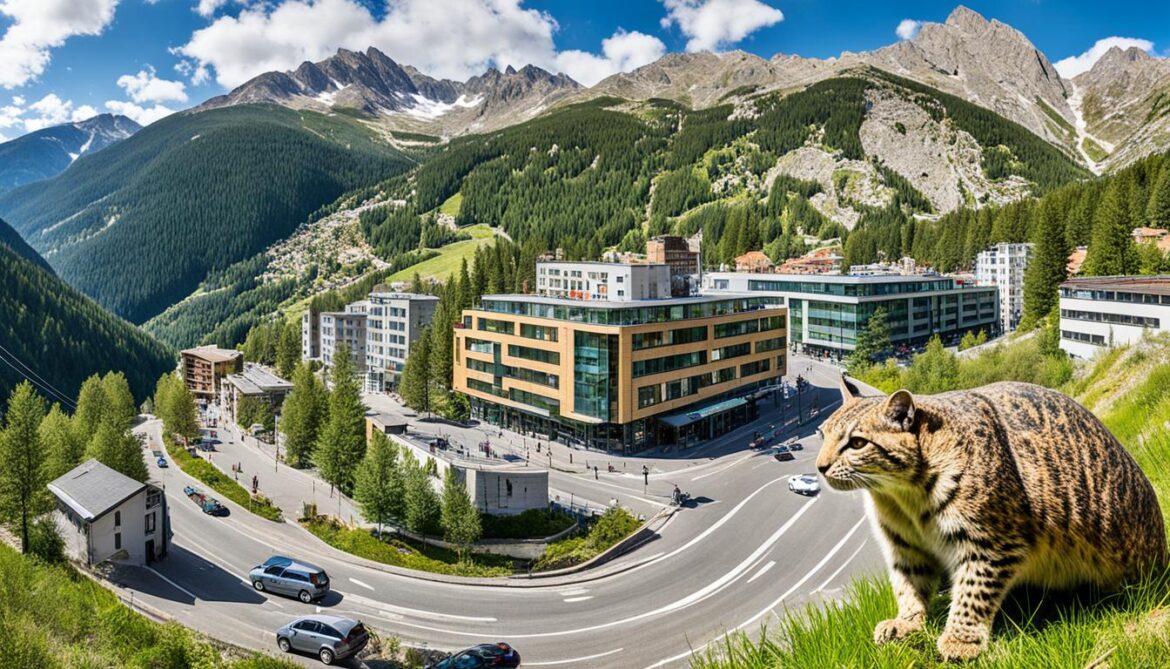
| Endangered Species | Threats |
|---|---|
| Pyrenean Desman | Habitat loss, pollution |
| Bearded Vulture | Habitat loss, climate change |
The Ecological Importance of Andorra’s Biodiversity
Andorra’s biodiversity plays a crucial role in maintaining the health and stability of its ecosystem. The presence of diverse species contributes to the resilience of the ecosystem, enabling it to adapt to environmental changes and disturbances. This biodiversity provides valuable ecosystem services that benefit both humans and the natural environment.
One of the essential ecosystem services provided by Andorra’s biodiversity is climate regulation. Through processes like carbon sequestration and oxygen production, diverse plant and animal species help regulate the climate and mitigate the impacts of climate change. This is particularly important in the face of increasing global temperatures and the resulting environmental challenges.
Additionally, Andorra’s biodiversity contributes to the purification of air and water. The presence of varied vegetation and microorganisms aids in filtering pollutants and maintaining clean air quality. Furthermore, diverse ecosystems help in water purification by capturing and retaining sediments, nutrients, and other pollutants, ensuring the provision of clean and safe water sources.
Another key aspect of Andorra’s biodiversity is its significance in maintaining ecosystem stability and balance. Each organism within an ecosystem plays a specific role, creating intricate webs of interactions. The removal of just one species can have far-reaching consequences, disrupting the delicate balance and leading to cascading effects on other species and ecosystem functions. Conserving biodiversity helps preserve these intricate relationships and ensures the stability of the entire ecosystem.
“The removal of just one species can disrupt the delicate balance and lead to cascading effects on other species and ecosystem functions.”
Despite its importance, Andorra’s biodiversity faces threats from various human activities, including habitat destruction, fragmentation, invasive species, and pollution. To address these challenges, conservation strategies are being implemented. These strategies include the establishment of protected areas, habitat restoration projects, and the adoption of sustainable land-use practices.
Protecting and conserving Andorra’s biodiversity is not only essential for the continued provision of ecosystem services but also for the preservation of cultural and aesthetic values. Biodiversity adds beauty and uniqueness to the landscape, making Andorra an attractive destination for ecotourism and outdoor activities.
Conservation Strategies for Andorra’s Biodiversity
As part of its commitment to biodiversity conservation, Andorra has implemented several key strategies:
- Establishment of protected areas: Andorra has designated nature reserves and protected areas to safeguard critical habitats and species.
- Habitat restoration: Efforts are underway to restore degraded habitats and promote the recovery of biodiversity.
- Sustainable land-use practices: Policies and practices are being implemented to ensure that human activities have minimal negative impacts on biodiversity and ecosystems.
- Public awareness and education: Raising awareness about the importance of biodiversity conservation is crucial for garnering public support and participation.
- Collaboration and research: Partnerships with international organizations and ongoing research projects contribute to a better understanding of Andorra’s biodiversity and inform conservation efforts.
By implementing these strategies, Andorra aims to protect and conserve its unique biodiversity for the benefit of current and future generations, ensuring the continued provision of valuable ecosystem services and the preservation of its natural heritage.
| Conservation Strategies | Description |
|---|---|
| Protected areas | Designation of nature reserves and protected areas to safeguard critical habitats and species. |
| Habitat restoration | Efforts to restore degraded habitats and promote the recovery of biodiversity. |
| Sustainable land-use practices | Implementation of policies and practices that minimize negative impacts on biodiversity and ecosystems. |
| Public awareness and education | Raising awareness about the importance of biodiversity conservation to encourage public support and participation. |
| Collaboration and research | Partnerships with international organizations and ongoing research projects to better understand Andorra’s biodiversity and inform conservation efforts. |
By implementing these strategies, Andorra aims to protect and conserve its unique biodiversity for the benefit of current and future generations, ensuring the continued provision of valuable ecosystem services and the preservation of its natural heritage.
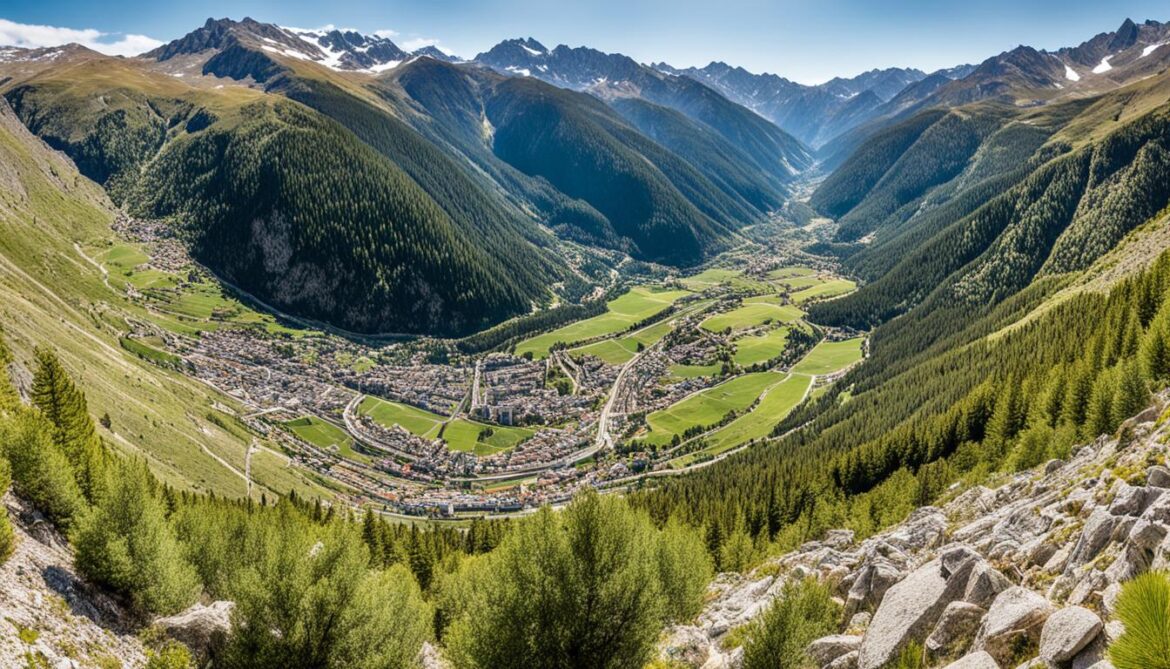
Biodiversity Research and Initiatives in Andorra
Andorra’s unique biodiversity has attracted scientists and organizations to conduct research and conservation initiatives. The Andorra Biodiversity Monitoring Program plays a crucial role in monitoring changes in biodiversity using various scientific methods. Through continuous data collection and analysis, this program helps track the health of Andorra’s ecosystems and identifies trends that inform conservation efforts.
*Andorra Sustainable Tourism Observatory focuses specifically on sustainable tourism practices. Recognizing the potential impact of tourism on the environment and biodiversity, this observatory collaborates with local businesses, government entities, and community stakeholders to promote responsible tourism and minimize negative impacts on Andorra’s natural landscapes. By developing sustainable tourism strategies, they aim to strike a balance between supporting the country’s economy and preserving its unique natural heritage.
*The Andorra Center for Biodiversity Research and Conservation is a key player in advancing scientific understanding and conservation of Andorra’s biodiversity. Collaborating with international partners, this center conducts research projects to explore the ecological significance of Andorra’s flora and fauna. Through their initiatives, they aim to develop innovative conservation strategies and contribute to global knowledge on biodiversity conservation.
The government of Andorra demonstrates its commitment to biodiversity conservation through policies and collaboration with scientists and conservation organizations. By supporting research initiatives, implementing protective measures, and engaging in international conservation efforts, the government helps ensure the long-term sustainability of Andorra’s unique ecosystems.
“Understanding the intricate relationships within Andorra’s ecosystems and developing effective conservation strategies require interdisciplinary research and collaboration. The scientific community, conservation organizations, and the government of Andorra all play a critical role in preserving the country’s remarkable biodiversity for future generations.”
Andorra Biodiversity Monitoring Program Key Objectives:
- Track changes in species distribution and abundance.
- Assess the impact of land-use changes on biodiversity.
- Monitor the health of ecosystems and detect signs of degradation.
- Identify emerging threats to biodiversity and propose mitigation measures.
Andorra Sustainable Tourism Observatory Initiatives:
- Promoting environmentally friendly tourism practices.
- Conducting environmental impact assessments of tourism activities.
- Encouraging the adoption of sustainable tourism certifications.
- Developing educational programs to raise awareness about responsible tourism.
Research Projects by Andorra Center for Biodiversity Research and Conservation:
- Study on the effects of climate change on alpine plant diversity.
- Assessment of the ecological role of keystone species in Andorra’s ecosystems.
- Investigation of habitat connectivity for wildlife conservation.
- Evaluation of the effectiveness of ecological restoration projects in Andorra.
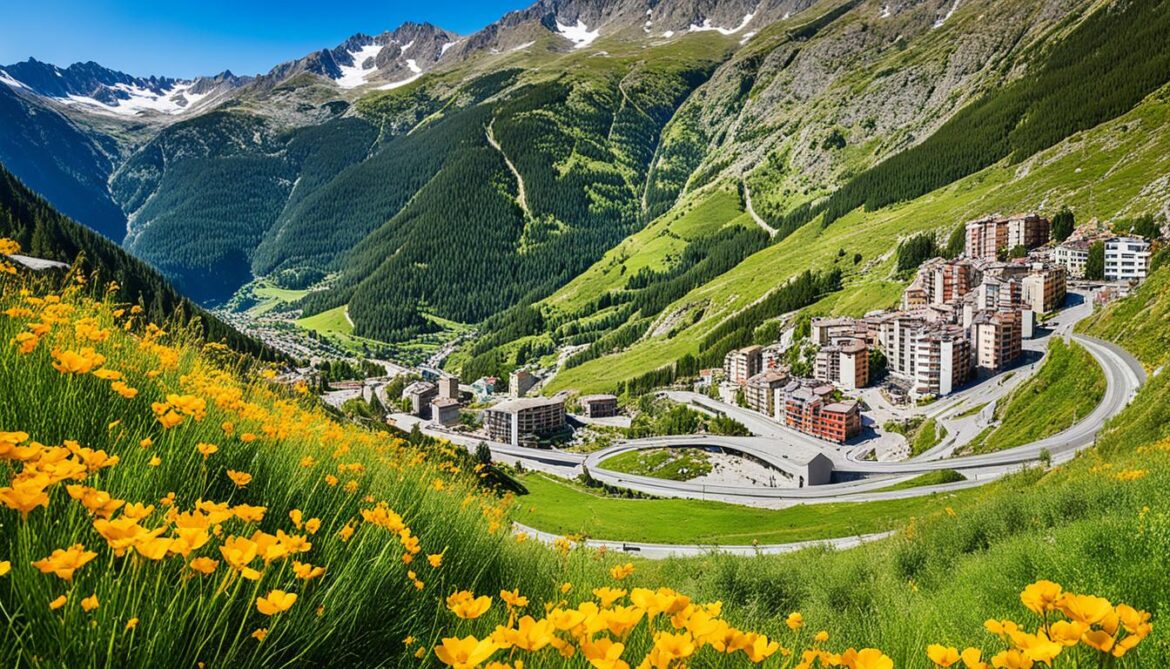
| Organization | Focus | Collaborations |
|---|---|---|
| Andorra Biodiversity Monitoring Program | Monitor changes in biodiversity | – |
| Andorra Sustainable Tourism Observatory | Promote sustainable tourism | Local businesses, government entities, community stakeholders |
| Andorra Center for Biodiversity Research and Conservation | Advance scientific understanding, develop conservation strategies | International research institutions, conservation organizations |
Biodiversity Hotspots in Andorra
Andorra, a picturesque country nestled in the Pyrenees mountains, is not only known for its stunning landscapes but also for its rich biodiversity. The country is home to several biodiversity hotspots, where a high concentration of species thrive and contribute to the overall ecological diversity of the region.
“The biodiversity hotspots in Andorra are crucial for the survival of numerous plant and animal species, making them a top priority for conservation efforts,” says Dr. Maria Lopez, a renowned biologist and conservationist.
One such hotspot is the Madriu-Perafita-Claror Valley, a UNESCO World Heritage Site. This pristine valley boasts a diverse range of ecosystems, including forests, meadows, and rivers, providing habitats for numerous species. The valley’s unique geological formations and isolated location have resulted in the evolution of several endemic plant species found nowhere else in the world.
Another notable hotspot is the Coma Pedrosa-Pic del Pla de l’Estany Natural Park. This protected area is characterized by its rugged mountain landscapes, stunning alpine meadows, and crystal-clear lakes. The park is home to a variety of wildlife, including the elusive Pyrenean chamois and the charismatic bearded vulture.
The Estany de l’Illa Nature Reserve is also considered an important biodiversity hotspot in Andorra. Located near the border with Spain, this nature reserve encompasses a beautiful lake surrounded by dense forests and wetlands. It provides a haven for migratory birds and supports a wide range of aquatic species.
Conservation initiatives and research projects are underway to better understand and protect the biodiversity in these hotspots. The Andorran government, in collaboration with local and international conservation organizations, is implementing measures to preserve these critical habitats and ensure the long-term survival of the unique species that call them home.
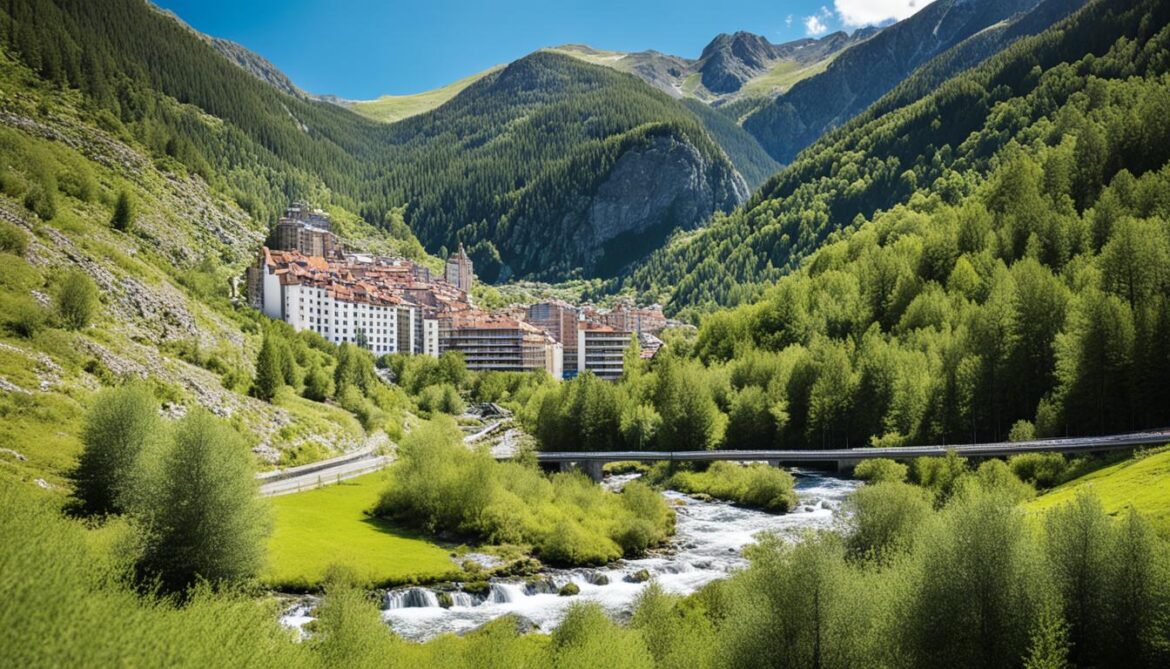
Andorra’s Biodiversity Hotspots
| Biodiversity Hotspot | Location | Key Features |
|---|---|---|
| Madriu-Perafita-Claror Valley | Central Andorra | – UNESCO World Heritage Site – Diverse ecosystems – Endemic plant species |
| Coma Pedrosa-Pic del Pla de l’Estany Natural Park | Northwestern Andorra | – Rugged mountain landscapes – Alpine meadows – Wildlife diversity |
| Estany de l’Illa Nature Reserve | Southern Andorra | – Beautiful lake – Dense forests – Wetland habitats |
The preservation of these biodiversity hotspots is crucial for maintaining Andorra’s ecological balance and ensuring the continued existence of its unique flora and fauna. Ongoing efforts to conserve these areas will not only protect the natural heritage of Andorra but also contribute to the global conservation of biodiversity.
Climate and Biodiversity in Andorra
Climate change has a significant impact on the biodiversity of Andorra. As temperatures rise and weather patterns shift, the delicate balance of ecosystems is disrupted, affecting both plant and animal species. To effectively conserve biodiversity in Andorra, it is crucial to monitor climatic variability and understand its influence on the environment.
By studying the relationship between climate change and biodiversity, scientists gain valuable insights into the vulnerabilities of different species and ecosystems. This understanding helps inform conservation strategies and guides efforts to mitigate the impacts of climate change.
Monitoring climatic patterns and trends in Andorra is essential to assess the ongoing changes and their potential effects. The collection of data related to temperature, precipitation, and snow cover enables scientists to track long-term climatic shifts and predict their consequences on biodiversity.
Conservation initiatives that focus on biodiversity adaptation and resilience can help safeguard Andorra’s unique ecosystems. By implementing strategies such as habitat restoration, protected area management, and sustainable land-use practices, the country can minimize the negative impacts of climate change and promote the conservation of its rich biodiversity.
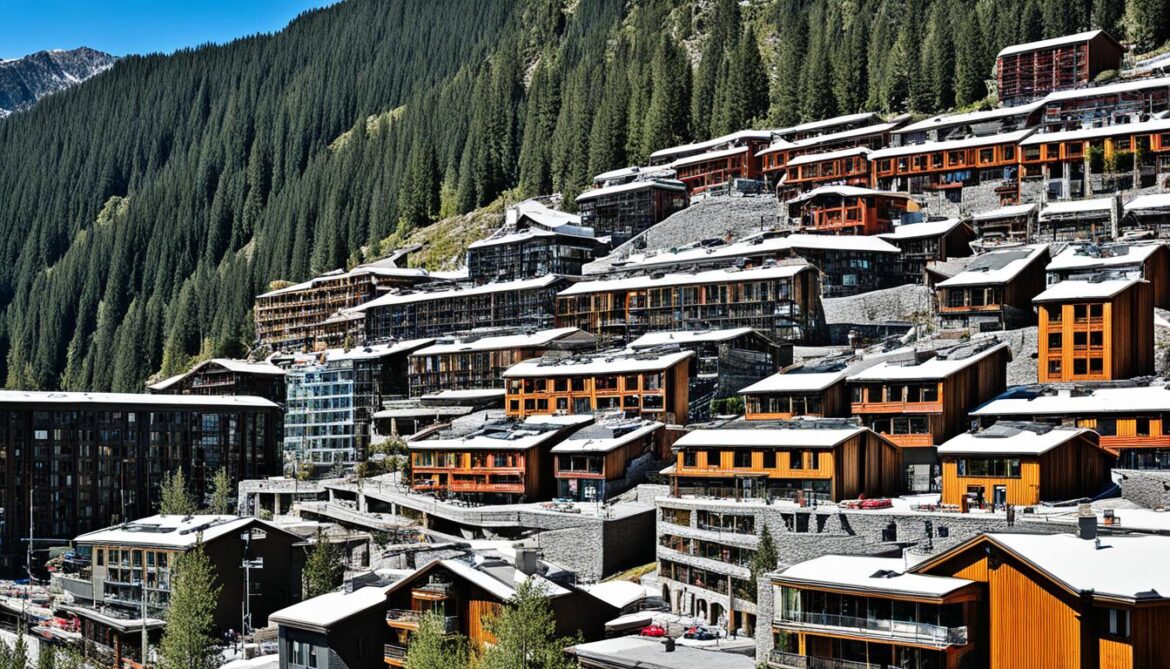
Climate-related challenges faced by Andorra’s biodiversity:
- Changes in temperature and precipitation patterns that affect species’ behavior, reproduction, and distribution.
- Increased frequency and intensity of extreme weather events, such as heatwaves, droughts, and heavy rainfall, which can disrupt ecosystems.
- Altered snowfall patterns and reduced snow cover, impacting species that depend on winter conditions for survival and reproduction.
- Rising temperatures leading to the contraction and upward shift of vegetation zones, affecting plant communities and the species that rely on them.
Conservation strategies for climate change adaptation:
Efforts to conserve biodiversity in the face of climate change include:
- Establishing interconnected networks of protected areas to facilitate species movement and adaptation.
- Implementing habitat restoration projects to enhance ecosystem resilience.
- Integrating climate change considerations into land-use planning and development.
- Engaging in public awareness campaigns and education programs to foster a culture of environmental stewardship.
- Collaborating with international organizations and researchers to share knowledge and best practices for climate change adaptation and biodiversity conservation.
| Biodiversity Conservation Strategies | Climate Change Adaptation Strategies |
|---|---|
| Protecting key habitats and ecosystems | Establishing interconnected networks of protected areas |
| Restoring degraded habitats | Implementing habitat restoration projects |
| Raising public awareness about biodiversity | Engaging in public awareness campaigns and education programs |
| Conducting scientific research on biodiversity | Collaborating with international organizations and researchers |
Land Conservation and Biodiversity in Andorra
Protecting land and conserving natural values are integral to the conservation of biodiversity in Andorra. The Andorran government and conservation organizations have recognized the importance of land-use change in influencing the natural environment and preserving scenic resources. Efforts are made to understand and address these changes to ensure the long-term sustainability of Andorra’s unique ecosystems.
By monitoring land-use change, researchers and policymakers can track alterations in land cover, such as deforestation, urbanization, and agricultural expansion. This knowledge enables informed decision-making, guiding conservation strategies that mitigate potential negative impacts on biodiversity. Understanding the effects of land-use change on natural habitats is crucial for implementing effective measures to protect Andorra’s rich biodiversity.
Natural values, including landscapes, habitats, and ecosystems, are also significant contributors to biodiversity conservation. Andorra’s diverse natural values, such as the Pyrenees mountains, alpine forests, and freshwater systems, support a wide range of plant and animal species. Conserving these natural values is essential for maintaining ecological balance and promoting the well-being of both wildlife and human communities.
In addition to land-use change, analyzing natural hazards plays a crucial role in preserving biodiversity and ensuring ecosystem resilience. By studying hazards such as landslides, floods, and wildfires, researchers can anticipate potential changes to the environment and assess their impact on biodiversity. Managing and mitigating these hazards is essential for preventing habitat destruction and safeguarding the vulnerable species that rely on these ecosystems.
In conclusion, land conservation and the preservation of natural values are vital components of biodiversity conservation in Andorra. By monitoring land-use change and understanding the significance of natural hazards, stakeholders can implement effective conservation strategies that protect Andorra’s unique ecosystems and ensure the long-term survival of its diverse flora and fauna.
Conclusion
Conservation efforts are vital for protecting Andorra’s biodiversity and ensuring the long-term survival of its unique species. The ecological importance of biodiversity in Andorra cannot be overstated. By preserving natural habitats, monitoring endangered species, and implementing sustainable practices, we can take concrete steps towards maintaining biodiversity and the delicate balance of Andorra’s ecosystems.
Continued research and collaboration with international partners are essential in understanding the significance of Andorra’s biodiversity and addressing the threats it faces. By studying the impacts of climate change, monitoring land-use changes, and analyzing natural hazards, we can develop effective conservation strategies specifically tailored to preserve the natural beauty and ecological diversity of Andorra.
It is our collective responsibility to protect Andorra’s biodiversity for future generations. The conservation efforts underway, such as the establishment of nature reserves and protected areas, highlight the commitment of both the government and conservation organizations. By raising awareness about the importance of biodiversity and engaging in sustainable practices, we can create a positive impact on the preservation of Andorra’s unique natural heritage.




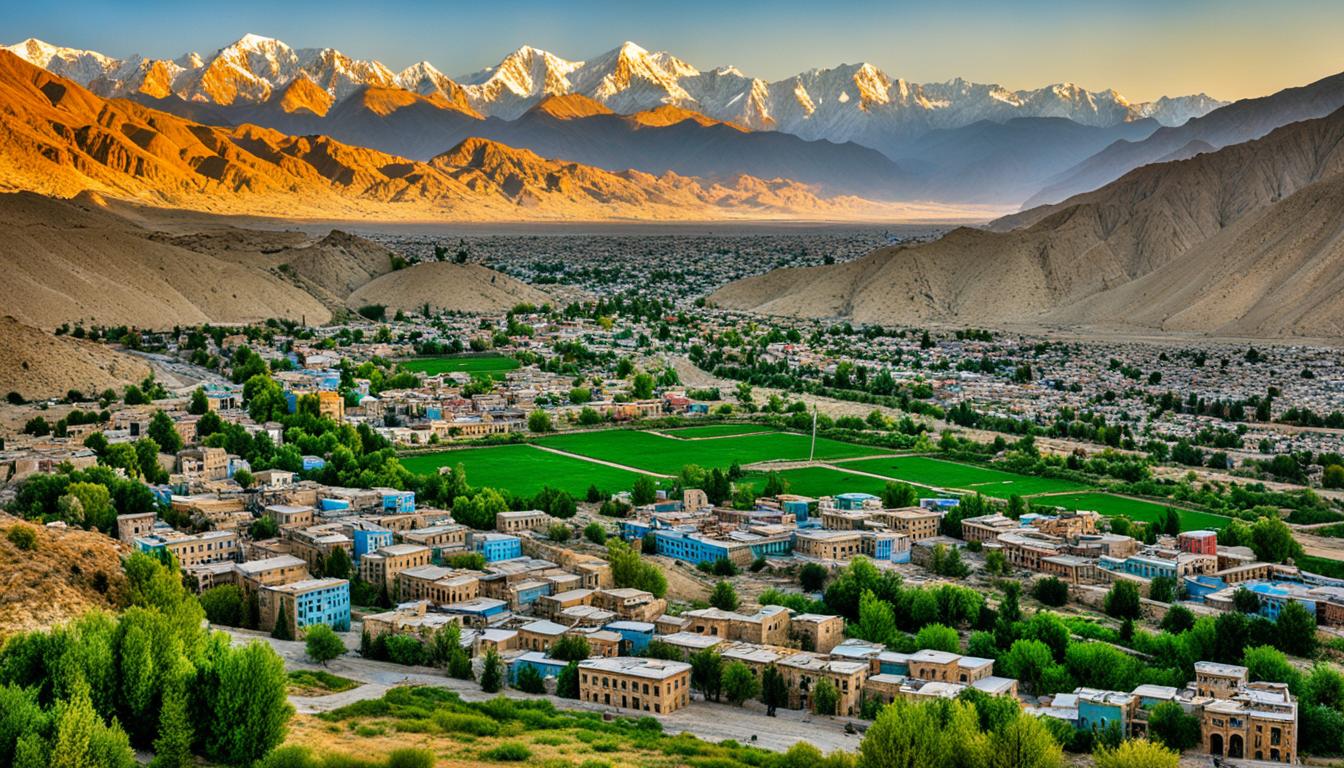

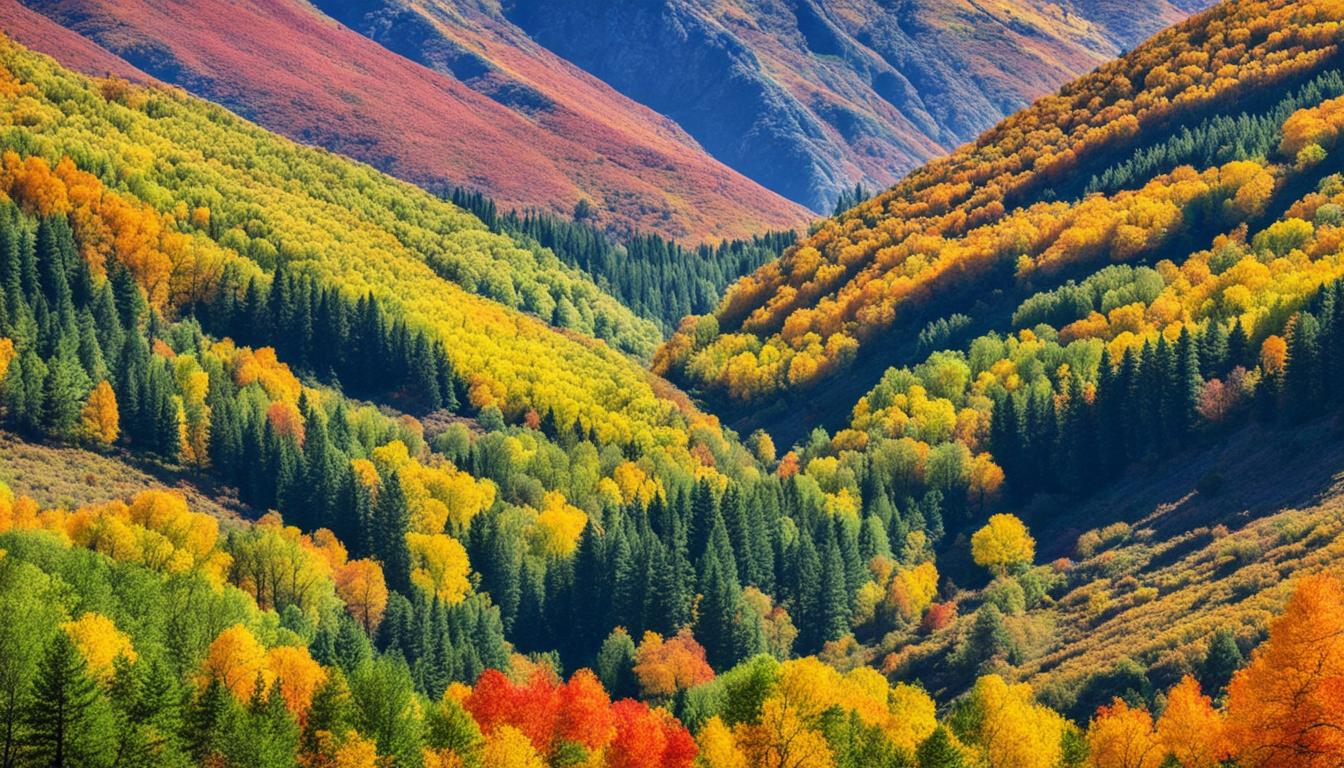
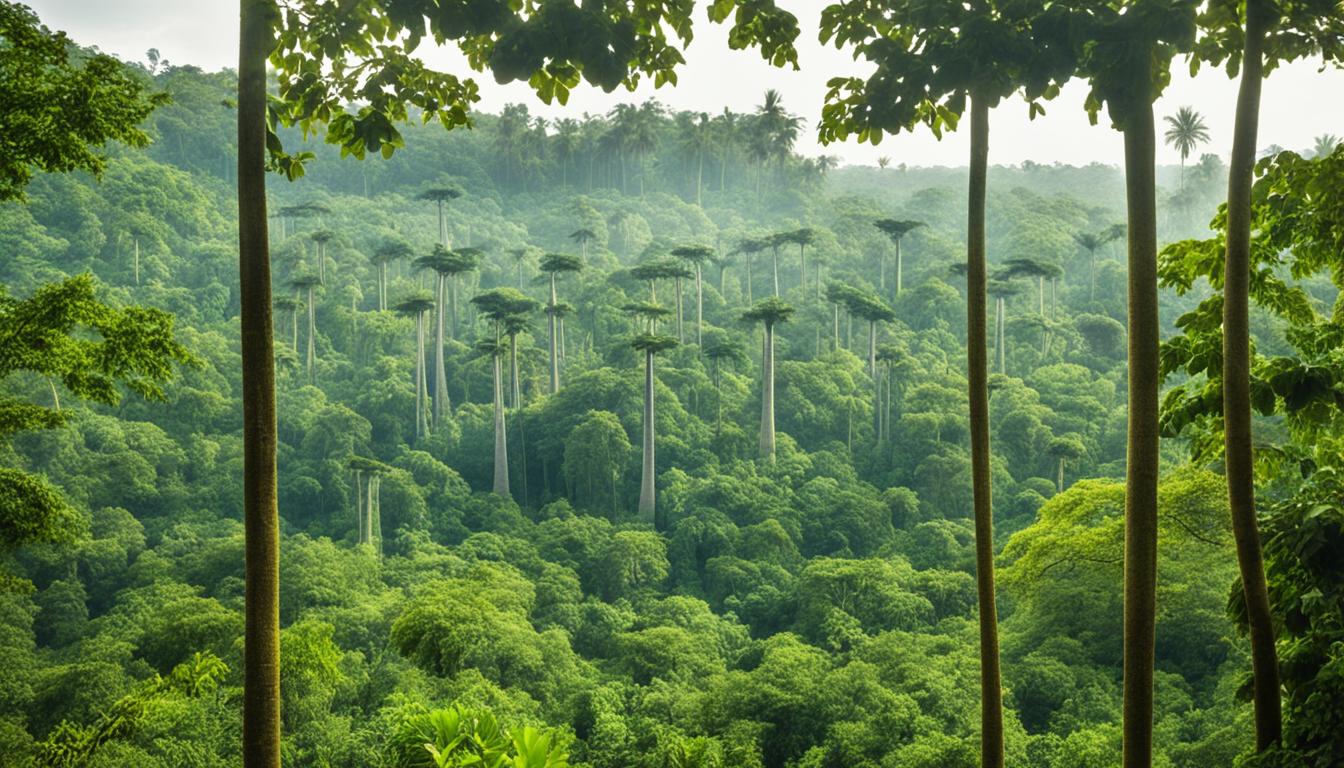

Louw Griffiths
4 months agoCONCERNED PERMANENT RESIDENT OF ANDORRQ:
Very impressive website and conservation in Andorra, we recently moved here and what a magical peaceful place that captured my heart instantly. Conserving nature and animals is a passion of mine and we’ve bought an empty plot near Pal ski resort to enjoy and live in this quiet wonderful natural environment. It is near Plat de Borras which now, since the Olympics, has become a shooting range? I can’t tell you the horrid noise going on All weekend. I don’t particularly care about humans the way I care about animals. As there is hardly any wildlife left because of human destruction of nature, now this ongoing gunshots all day over the weekends must be even more destructive to poor animal ears .
I can compare this with ruthless fireworks also going on at several celebrations destroying animals nerves systems. The people that have pets will know exactly what I’m talking about.
If I may make a suggestion, Since the humans constantly are trying to evolve into being better,
There are currently guns and weapons available that makes no noise and is environmentally friendly or the shooting should definitely have less times available to this anoying destructive noise.
Please can this be a matter of urgency because if I have to listen to gunshots all weekend every weekend of my summertime in the hills of Andorra I seriously don’t know what I have to do ? My pets are disturbed all weekend.
So let’s put nature as a first concern, care about our animals and then humans could reap the benefits of silent nature as well
Please !
Jackie De Burca
4 months agoThis sounds truly awful. Thank you for bringing it to our attention.
Which body is in charge of this? So we can contact them.